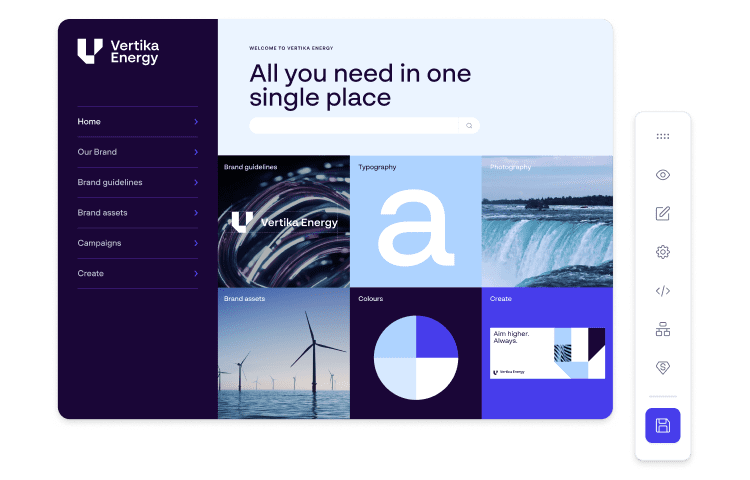This content has been automatically translated and may include minor variations.
Every photo, video and archived document is part of your company’s brand narrative. Yet too often these assets are hidden in old drives or out‑of‑the‑way servers – unavailable when you need them most. Ensuring corporate heritage remains both safe and accessible presents digital asset managers with a complex balancing act.
This guide explores how a purpose-built Digital Asset Management system can help preserve your heritage, reinforce brand culture, and accelerate creative workflows. From brand portal technology to GDPR compliance and templated content creation, we’ll dive into the key capabilities that make heritage asset a living resource, not a forgotten archive.
Why corporate heritage matters
Corporate heritage is the history of your business. From founding documents to milestone campaign reels, from product prototypes to workplace snapshots, these are the artifacts that chronicle your brand’s journey from the beginning to the present day.
Heritage assets serve three strategic purposes:
Strengthening brand authenticity: Archival photos support genuine storytelling that can help build emotional connections with audiences and distinguish you in crowded markets.
Fostering cultural continuity: Heritage assets can be useful for welcoming new hires and engaging existing employees by demonstrating shared values and showing “who we are”.
Mitigating compliance risk. Accurate historical records of product designs, financial disclosures, and consented imagery can be critical, especially in heavily regulated industries.

Over 50,000 brand assets
are often stored in companies’ DAM systems
Source: cmotech.uk

Over 50,000 brand assets
are often stored in companies’
DAM systems
Source: cmotech.uk
Common challenges associated with digital archives
Legacy assets are notoriously difficult to control, with industry benchmarks suggesting that teams lose an average of four hours a week just hunting for the materials they need.
Common digital asset management issues include:
- Siloed storage: With film archives in vaults, scanned photos on local drives, and digital videos in forgotten folders, nobody is sure where to look for the assets they need.
- Inconsistent metadata: Missing dates, unclear usage rights, and ad hoc tagging hide assets from search.
- Legal uncertainty: Lack of automated consent tracking means rights may expire unnoticed, risking GDPR violations or license breaches.
How modern DAM software bridges the corporate heritage gap
A mature Digital Asset Management system ensures heritage assets are compliant and accessible by bringing scattered archives together in one secure platform. But that’s not all it does. Here are some of the additional benefits offered by the best Digital Asset Management software:
- Integrated brand portals. Centralize guidelines, logos, tone-of-voice documents and heritage galleries in a dedicated brand portal. Frontline staff and agencies can access the right assets and instructions without guesswork, ensuring every video, social post, or print ad aligns with your corporate style.
- GDPR compliance manager. Automate consent capture, time-based permissions and instant asset revocation. Whether you’re using customer testimonials, employee headshots or licensed music, the system flags pending approvals and removes expired content – protecting you from fines and reputational damage.
- Templated content creation. Empower non-designers with smart templates that merge heritage imagery and brand elements. Need to promote your centennial anniversary? Teams can generate on-brand posters, social carousels, and event banners in minutes, freeing designers for high-value projects.
- Robust metadata and AI enrichment. Combine a consistent taxonomy with AI metadata tagging, facial recognition, and OCR, and even obscure heritage items become discoverable.
- Granular access controls. Separate restricted archives from public heritage galleries by defining role-based permissions.
This approach reduces duplication, ensures compliance, and accelerates time to market.

AI-powered DAMs can reduce asset retrieval times by up to 40%
Source: mordorintelligence.com

AI-powered DAMs can
reduce asset retrieval times
by up to 40%
Source: mordorintelligence.com
Best practices for heritage‑focused DAM implementations
- Start with a pilot. Choose a manageable archive, such as your first decade of product launches. Ingest, tag, and publish a curated exhibit. Measure search time reductions and stakeholder feedback to validate your approach.
- Define a metadata governance plan. Get archivists, marketers, and legal teams to agree on taxonomy and tagging conventions. Document standards in a central guide and enforce them via DAM templates and AI helpers.
- Automate compliance workflows. Configure GDPR-manager rules for consent capture and asset expiration. Use time-based permissions to ensure outdated materials don’t ever slip through by accident.
- Curate thematic heritage exhibits. Build collections to tell powerful brand stories that engage employees, investors, and customers alike.
- Integrate across the ecosystem. Connect your DAM with CMS, CRM, and intranet platforms, so heritage assets can be automatically incorporated into newsletters, training portals, and web pages.
- Measure and iterate. Track KPIs such as asset utilization rate, search efficiency, stakeholder adoption, and compliance incident counts. You can use the data to continue refining taxonomies, permissions, and brand portal designs
Turning your corporate heritage into a living resource
Corporate heritage can be so much more than a static archive. It can provide the basis for powerful brand-building, authentic storytelling, and cultural cohesion – as long as you have the tools to get disparate legacy assets under control.
By adopting a Digital Asset Management solution with integrated brand portals, GDPR compliance management and templated content creation, you turn hidden treasures into living assets that fuel creativity and brand trust.
Ready to future-proof your heritage and make managing digital assets easier than ever? Download our DAM buyer’s guide to discover the must-have features for preserving your brand legacy.
Future-proof your brand heritage
Discover the DAM features that turn legacy assets into living brand tools
Future-proof your brand heritage
Discover the DAM features that turn legacy assets into
living brand tools
Future-proof your brand heritage

FAQs
Corporate heritage refers to the historical assets that document a company’s evolution, such as photos, videos, and founding documents. These materials can be used to strengthen brand authenticity and create a sense of shared company culture, as well as mitigating compliance risks in regulated industries.
Legacy archives often suffer from siloed storage, inconsistent metadata, and unclear usage rights. These issues can lead to lost productivity, as team members waste time searching for hard-to-find files. It can also mean brand assets are underused.
Modern DAM solutions like Papirfly centralize heritage assets, enforce metadata standards and automate GDPR compliance. This makes archives accessible, searchable, and usable across teams and campaigns.
Key features include integrated brand portals, GDPR consent tracking, templated content creation, and granular access controls to manage different levels of asset visibility and permissions.
Follow these key steps:
1. Start with a pilot archive
2. Establish a clear metadata governance plan
3. Automate compliance workflows
4. Curate thematic collections
5. Integrate with your wider tech stack
6. Track performance metrics to improve over time


